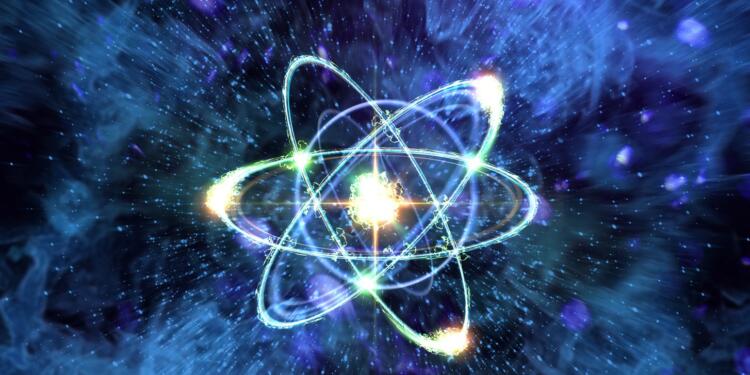What is nuclear fusion: US scientists have announced a major breakthrough in their efforts to recreate nuclear fusion. It is a technology that has been pursued for decades and promises a potential source of near-limitless clean energy.
This week, scientists at the National Ignition Facility, which is part of the Lawrence Livermore National Laboratory (LLNL), announced a major breakthrough in nuclear fusion.
Researchers have finally produced more energy from a nuclear fusion experiment than the energy (laser) used to initiate it. This marks the first time that more energy has been produced from a nuclear fusion reaction than was used to power it. The accomplishment is a major step forward in the pursuit of clean, safe, and sustainable nuclear energy.
What is nuclear fusion
Nuclear fusion is a process that occurs in the cores of Sun and other stars. In fusion reactions, atomic nuclei (which are typically hydrogen atoms) combine to form a single, heavier nucleus. These fusion releases large amounts of energy, which is what powers the Sun and other stars. The fusion process requires immense pressures and temperatures, often up to 100 million degrees Celsius. At these extreme conditions, light atoms of hydrogen are forced together, fusing into helium atoms, releasing energy in the process.
Nuclear fusion is a much cleaner energy source than any other fuels, as it does not create any of the harmful emissions that are associated with burning fossil fuels. Unlike nuclear fission, it produces a small amount of radioactive waste that is only radioactive for a short period of time.
For nearly seven decades, scientists have been attempting to generate this clean energy on earth by using deuterium and tritium, two isotopes of hydrogen, to power fusion plants.
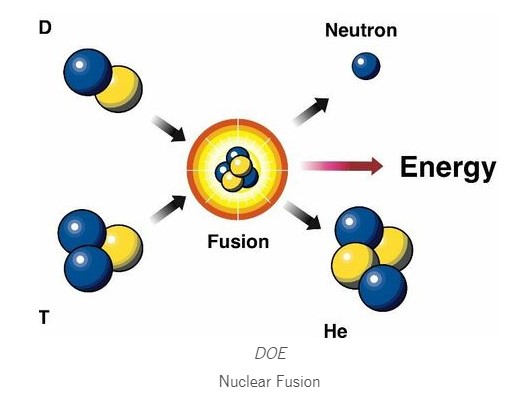
Since deuterium can be found in seawater and tritium can be produced by irradiating lithium (which is a common element used in batteries), these isotopes are relatively accessible. This means that fusion could potentially become a major source of energy in the future.
The deuterium content in a single litre of water has the potential to generate the same amount of fusion energy as the burning of 300 litres of oil.
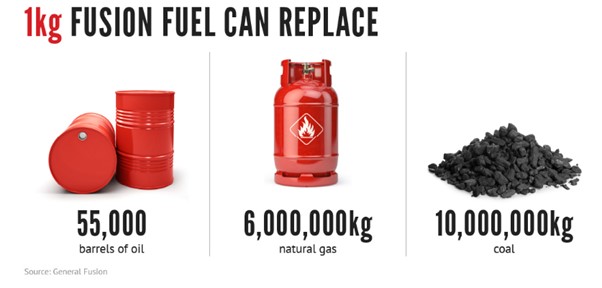
Ultimately, the goal is to create fusion power plants that produce more energy than they use, while also keeping the costs low enough to power a home.
Why it is different from Nuclear Fission
Gaze upon the sun during the day and marvel at one of the most remarkable examples of nuclear energy. Within the sun, intense heat and gravitational forces create an environment in which fusion reactions occur, releasing a vast amount of energy.
Fission is a process in which an atomic nucleus splits into two or more smaller nuclei, releasing a large amount of energy in the form of heat and radiation. This energy is released when neutrons are accelerated and collide against somewhat unstable isotopes (atoms with the same number of protons but different number of neutrons), causing them to break apart and form smaller, more stable nuclei.
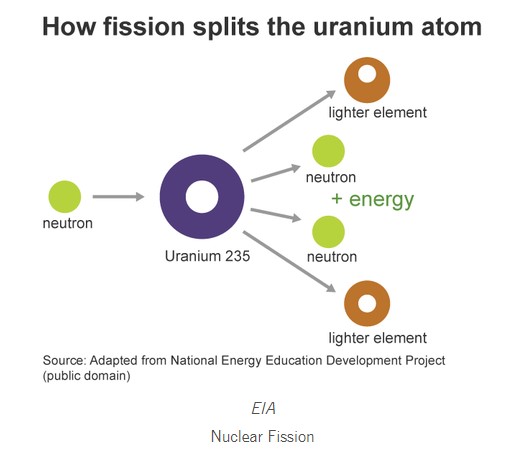
During the fission process, the neutron is accelerated and directed towards a Uranium-235 nucleus, which is the target nucleus typically used in modern nuclear power reactors.
This process of division results in the splitting of the target nucleus, yielding two smaller isotopes (the fission products) as the end result. The process of nuclear fission produces a vast amount of energy in the form of high-speed neutrons. This energy then heats up water in nuclear reactors, providing an efficient source of energy to generate electricity. Through a chain reaction, the neutrons can also initiate other fission reactions, resulting in a large amount of energy being released.
In contrast, fusion is the process of two low-mass isotopes, usually isotopes of hydrogen, combining together in an environment of high pressure and temperature. Specifically, Tritium and Deuterium (Hydrogen-3 and Hydrogen-2, respectively) come together to form a neutron and a helium isotope. In addition, a vast amount of energy is unleashed, which is several times more powerful than the energy created from fission.
Fission, which is used in nuclear power reactors, can be controlled and has been in use for some time. Fusion, however, is not yet developed enough to be used to generate a huge amount of power. Fusion presents a tantalising possibility, as it produces less radioactive waste than fission and has an almost inexhaustible source of fuel.
Both fission and fusion produce energy after nuclear reactions, but the processes are completely different. While different, both processes have a huge role in the past, present and future of energy creation.
The Exciting Quest to Achieve Fusion Ignition
Fusion ignition is an exciting breakthrough in the world of science that has the potential to revolutionise our energy sources. Fusion ignition is the term for a fusion reaction. Through this process, researchers can now create a self-sustaining fusion reaction that produces more energy than is consumed. Up until now scientists were only able to use nuclear fission.
The National Ignition Facility (NIF) uses a cutting-edge technique called inertial confinement fusion (ICF). This technique involves using lasers to precisely target a tiny pellet of hydrogen plasma, triggering the fusion ignition process.
LLNL’s experiment succeeded in surpassing the fusion threshold by delivering 2.05 megajoules (MJ) of energy to the target, resulting in 3.15 MJ of fusion energy output, as reported by the U.S. Department of Energy.
Start-ups are jumping on to it
The recent advancement in nuclear fusion is expected to attract substantial investments in the technology, which in turn could revolutionise the world’s energy sector with an abundance of clean energy.
Fusion technology has become increasingly popular in recent years, drawing the attention of governments and private companies alike.
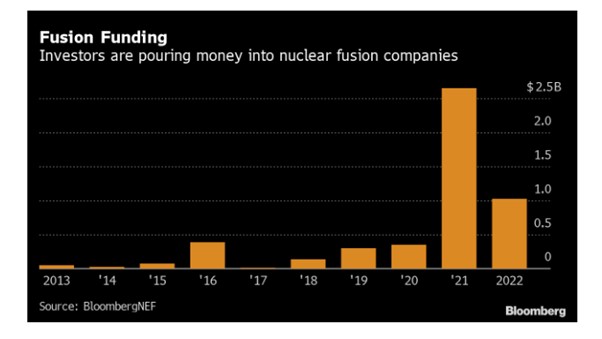
Estimates from Bloomberg Intelligence suggest that the fusion market could be worth as much as $40 trillion in the future. Companies such as Chevron and Google have already expressed an interest in investing in this emerging technology.
In addition to its potential for energy production, fusion is anticipated to have applications in other areas such as space propulsion, marine transportation, medical treatments, and industrial processes that require large amounts of heat.
Investors are projected to invest over one billion dollars in the technology this year. This figure is lower than last year’s amount of over 2.6 billion dollars, but still three times higher than 2020’s amount. Chris Gadomski, Chief Nuclear Analyst for BloombergNEF takes it as a sign of increasing trend of investment in technology.
Challenges and attempts to overcome them
Despite the recent breakthrough, there are still many technological and engineering challenges that must be addressed before fusion energy can be commercially viable. Numerous companies, such as Commonwealth Fusion Systems, TAE Technologies Inc., and Helion Energy Inc. were among the companies that attracted significant funding last year.
Kim Budil, the director of the Lawrence Livermore National Laboratory, believes that it will likely take a decade before nuclear fusion energy can be utilised on a commercial scale.
The US is also increasing support for fusion technology, with a $50 million program to fund research, announced in September. India should also grab this opportunity with both hands. Unlike nuclear fission, we can invest in this technology more precisely and timely.
Over the years, scientists have developed a plan for a fusion nuclear reactor known as the International Thermonuclear Experimental Reactor (ITER). This reactor is currently being constructed in Southern France with the assistance of 35 countries, including India, which is one of the seven major partners, such as the European Union, the US, Russia, Japan, South Korea, and China.
Also Read: We predicted a TATA Nano electric to be relaunched even before Ratan Tata did 😉
India should get more pro-active
When investors are ready to pour heavy amounts into nuclear fusion technology, why not an Indian brain can develop something in this field? The guilt gets real when we know that since 2005, India has been a member of the ITER project.
The Institute for Plasma Research in Ahmedabad, India, is a key partner in the ITER project, a multinational collaboration to develop a ground-breaking nuclear fusion reactor. As part of the Department of atomic energy, the Institute is constructing components of the ITER reactor and conducting research and development activities to further the project’s progress.
India has made immense progress in the field of fusion energy research with its own Tokamaks (a machine and Fusion energy scientists believe that Tokamaks are the leading plasma confinement concept for future fusion power plants), Aditya. Since its initial operation in 1989, Aditya has been able to sustain a plasma temperature for 0.4 seconds. In 2016, the Tokamak was upgraded and it has been in the experimental phase since then.
Support TFI:
Support us to strengthen the ‘Right’ ideology of cultural nationalism by purchasing the best quality garments from TFI-STORE.COM


























